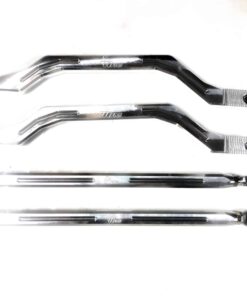UTV Radius Rods, Lets Talk Differences And Why
There are three ways that people usually start to consider updating their radius rods. The first happens when you’re driving through the backcountry, and everything seems to be fine until — WHACK! — you drive over a rock that’s just a little too big and your lowest factory radius rod snaps like a twig.
More often, you don’t even realize something is wrong until you’re done. You get off your machine and walk around to check everything out when you realize you’ve got a bend in one of the rods going to your wheel.
Sometimes, you only realize something is off when you make a clunking noise during braking or accelerating. You might notice that your tires have uneven wear and your steering’s loose while taking corners.
No matter how you find out, once you realize you need new radius rods there’s a lot to consider. To help you out, this the American Off-Roads guide on everything you absolutely need to understand about radius rods before you decide to upgrade.
Why Upgrade your UTV Radius Rods?
There’s a lot of information out there about radius rods. People call them radius arms, torque springs, and torsion bars. And a lot of drivers don’t think about upgrading them until it’s too late. But you can save yourself a lot of time and headaches if you get out in front of the problem and upgrade before you break one.
Let’s face it: stock UTV radius rods are weak. Most factory-issued rods will bend in rough terrain. And once a bend starts, it’s only a matter of time until they break completely.
A broken radius rod affects almost every part of your UTV suspension. It can lead to damaged trailing arms and, eventually, busted shocks along with worn out tires.
If you’re planning on serious off-roading, it’s usually worth your time and money to upgrade your stock rods to a sturdier option with more ground clearance. It might be pricier up front, but it can save you thousands of dollars later on. Many of the radius rods we sell, such as the NRP Radius Rods for the Polaris RZR XP 1000, come with a Lifetime Warranty.
The American made radius rods we sell run anywhere from $250 to nearly $1,000 for a full set, depending on the material, joints, and finish.
Pick High Clearance for Off Roading
There are two kinds of radius rods: arched and straight. If you’re an off roader who likes driving your buggy through more extreme environments, you’re going to want the extra ground clearance that high arched radius rods provide. The higher the arch in your radius rods, the less chance they’ll snag a log or rock.
Higher grade radius rods also hold up better when they snag a rock or a log. The larger diameter and billet aluminum body can take a good beating before they give.
If you’re more into racing, it may not be necessary to go with arched radius rods. As long as you stay on desert dunes-style courses and mostly flat raceways, going with straight radius arms can save you money without compromising performance.
Sometimes, straight rods can also be straightened out if they start to bend. That won’t solve your problem long term, but it can help you finish a race day.
The Clear Winner for Joints
When you’re thinking about upgrading your RZR or X3 radius rods, you might be surprised at the price difference between manufacturers. High-quality joints are one option that separates mid-priced radius rods from more expensive options.
Standard FK joints include nylon-injected liners. They cover about half of the joint and will need to be lubricated regularly to prevent the crazy squeaking noise they make when dry.
Your other option is FK JMX joints. These are true PFTEs, meaning they use a non-nylon material that covers the entire joint. That eliminates squeaking sounds completely without needing oil.

FK Bearings
JMX Upgraded On The Left, Standard Nylon on The Right

FK Bearings
JMX Upgraded On The Left, Standard Nylon on The Right
FK JMX joints are also thicker and more durable than standard FK joints. They will last longer, but you’ll pay more for them.
The other thing to consider is whether you want a direct fit or Heim joints.
A direct fit joint is the less-expensive option. They come the same length as your OEM, which makes them a good option for most drivers, although they don’t give you the ability to adjust the toe or the caster on your rear tires.
If you want to add more customization, you can pay a little extra for American-made Heim joints from, which give you the ability to add or reduce length. The best Heims on the market come from Fk Bearings.
But, as with most things, you get what you pay for.
Colors and Finishes
Like almost all the parts we sell at American Off-Roads, our radius rods are highly customizable. While shopping we offer different finishes colors and finishes to suit your machine.
Our LM UTV and NRP radius rods come in several colors. Other companies, like CT Race Worx, come in just black or raw.
Most every manufacturer offers raw and anodized coatings, but not all will do powder. LM-UTV offers powder colors for their X3 line, but not for their RZR radius rods. NRP offers only raw and anodized colors for both their Polaris and X3 radius rods.
Raw finishes have become popular because they’re easy to maintain. When the rods get scraped up — which they will — it’s easy to sand and polish them back to a new-looking shine.
An anodized coating penetrates a few millimeters into the actual metal of the radius rods, so small scratches and scrapes won’t change their look. However, deeper scrapes will reveal the raw color underneath.



























